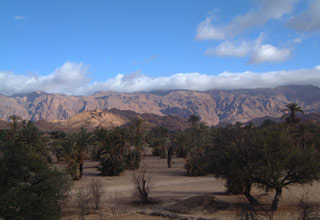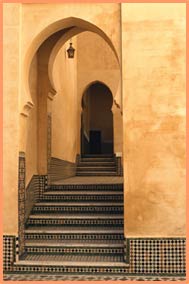History |
Cristel |
Tafraout
according
to Leo
The
warring days
While Leo makes no mention of Tafraout (not surprising, given that this small village community was created by the French, in the early 20th century, as an administrative center), he does describe the surrounding region: the Sus. Lodged in the Anti-Atlas mountains, Tafraout resembles other hillside communities, the attributes of which Leo does describe. He mostly remembers the fighstiness of these rugged mountain dwellers, and the harshness of the climate:
Morocco,
but in actuality only in control of Northern Morocco) to subdue the independent
spirited tribes around Marrakech:
This
accompanying mission was one of Leo's most important diplomatic assignments.
Leo was to be an attaché to this Cherif, member of the powerful Saadian
family, soon to be the ruling dynasty in Morocco (and overthrowing the
Wattasides who ruled from Fes). Leo accompanied him on his travels through
the region north and South of Marrakech (Kingdoms of Sus and Hea): "we
traveled here to bring peace" (78).
Actually, this Cherif was one of two sons of Muhammed as-Sa'di, who spearheaded the struggle against the Portuguese in Southern Morocco. In 1511 the latter had sent his two sons to Fes, to ask for the right to build an army. They succeeded and worked on their father's behalf until his death in 1517. By 1529, they had conquered most of Western Morocco, which they split evenly- one ruling from Marrakech and the other from Taroudant. Their increasing power became an obvious threat for the Wattaside ruler in Fes- erupting in an armed conflict in 1536. By 1545, Muhammad al Mahdi overcame both the Fes ruler and his rival brother, and became the first Saadian sultan of Marrakech. It is unclear which of the brothers Leo accompanied, but he must have held an important position in this delegation, as he witnessed many of the crucial conversations between the Cherif and the townspeople they visited: "They told the Cherif, and I witnessed this, that the population in these mountains could provide twenty thousand warriors" (85).
While Leo makes no mention of Tafraout (not surprising, given that this small village community was created by the French, in the early 20th century, as an administrative center), he does describe the surrounding region: the Sus. Lodged in the Anti-Atlas mountains, Tafraout resembles other hillside communities, the attributes of which Leo does describe. He mostly remembers the fighstiness of these rugged mountain dwellers, and the harshness of the climate:
|
 around Tafraout |
| "The Cherif Prince wanted to submit this population and exert taxes from it, but they resisted et constantly fought him. They remained independent until the year I visited this region, in 1513" (94) |
Actually, this Cherif was one of two sons of Muhammed as-Sa'di, who spearheaded the struggle against the Portuguese in Southern Morocco. In 1511 the latter had sent his two sons to Fes, to ask for the right to build an army. They succeeded and worked on their father's behalf until his death in 1517. By 1529, they had conquered most of Western Morocco, which they split evenly- one ruling from Marrakech and the other from Taroudant. Their increasing power became an obvious threat for the Wattaside ruler in Fes- erupting in an armed conflict in 1536. By 1545, Muhammad al Mahdi overcame both the Fes ruler and his rival brother, and became the first Saadian sultan of Marrakech. It is unclear which of the brothers Leo accompanied, but he must have held an important position in this delegation, as he witnessed many of the crucial conversations between the Cherif and the townspeople they visited: "They told the Cherif, and I witnessed this, that the population in these mountains could provide twenty thousand warriors" (85).
